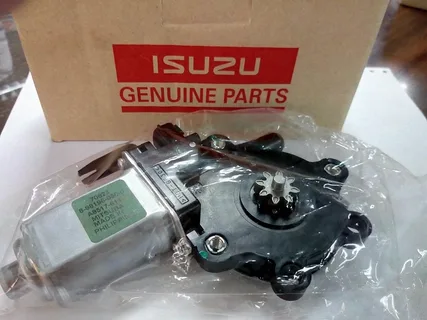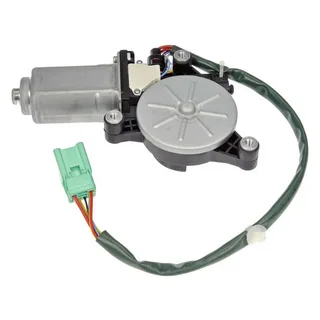The Isuzu D-Max, popular among pickup truck enthusiasts, combines robust performance with modern comfort features. Among these features, the isuzu dmax power window motor ensures a convenient and seamless driving experience. A functional Isuzu D-Max power window motor not only enhances comfort but also contributes to overall vehicle safety.
Overview of the Isuzu D-Max Power Window Motor
The power window motor in the Isuzu D-Max is a critical component that allows for the automatic movement of the vehicle’s windows. It operates by converting electrical energy into mechanical energy, facilitating the effortless raising and lowering of windows at the push of a button.
Integrated within the vehicle’s electrical system, this motor ensures a smooth and reliable operation of the windows, contributing to overall driving comfort and convenience. The proper functioning of this motor is essential for the seamless operation of the power windows.
Common Issues with Power Window Motors
Over time, power window motors in an Isuzu D-Max can develop various issues. These include the motor burning out due to overuse, gears wearing down, and electrical faults that disrupt its operation. Such problems often lead to windows stuck or moving slowly, compromising vehicle usability.
Additionally, debris and moisture can infiltrate the motor housing, exacerbating these issues. Regular checks and maintenance can mitigate some of these problems, ensuring the power window motor remains in good working condition for longer.
Signs of a Failing Power Window Motor
A clear sign of a failing power window motor is when the window fails to respond to the control switch. The window may remain completely unresponsive, refusing to move up or down.
Grinding or Clicking Noises
If you hear grinding or clicking noises when operating the power window, it could indicate that the motor is struggling to function properly. These sounds often accompany a weakened or damaged motor.
Sluggish Window Movement
Slower-than-usual window movement can be a failing power window motor symptom. As the motor weakens, opening or closing the window may take longer.
Window Stops Mid-Cycle
If the window stops moving mid-cycle, it’s likely a sign of a motor issue. The motor may not have enough power to complete the full range of motion.
Visible Damage to the Motor
In some cases, physical damage to the power window motor, such as broken wires or damaged gear, can be visible. This can lead to various malfunctions, including complete failure.
Early Detection and Preventive Measures: Dmax Power Window Motor
Recognizing these signs early on is crucial to prevent further damage and costly repairs of dmax power window motor. Regular maintenance, such as lubricating the window tracks and cleaning the motor components, can help extend the lifespan of the power window system.
If you suspect a failing power window motor, it’s advisable to consult a qualified technician for diagnosis and repair.
Diagnosing Power Window Motor Problems
Diagnosing issues with the Isuzu D-Max power window motor requires a systematic approach. Start by inspecting the vehicle’s fuse box for blown fuses related to the power windows. If fuses are intact, examine the wiring for signs of damage or disconnection.
Additionally, testing the motor with a multimeter can reveal electrical faults. If all preliminary checks are clear, the motor may need further inspection for internal faults.
Replacing the Isuzu D-Max Power Window Motor
Replacing the Isuzu D-Max power window motor requires some technical expertise and the appropriate tools. The process includes removing the door panel, disconnecting the defective motor, and installing a new one.
While it is possible to perform this task independently, seeking the assistance of a professional is advisable to ensure precision and efficiency. This approach helps avoid potential mistakes and correctly provides the new motor functions within the vehicle’s electrical and mechanical systems.
Choosing the Right Isuzu D-Max Window Regulator
Determine the exact model and year of your Isuzu D-Max Window Regulator. Identify the specific window regulator assembly where the motor is located (front left, front right, rear left, or rear right).
Check Motor Specifications
Ensure the motor’s voltage rating matches your vehicle’s electrical system. The amperage rating should be appropriate for the window regulator’s load. The motor’s RPM should be sufficient for smooth and efficient window operation.
4. Consult Your Vehicle’s Manual
Refer to your Isuzu D-Max’s owner’s manual for specific recommendations and part numbers. The manual may provide detailed information on compatible replacement motors.
Seek Professional Advice
Consult with a qualified mechanic or automotive specialist. They can provide expert advice based on your vehicle’s specific needs. They can also help you identify potential compatibility issues or installation challenges.
Purchase from Reliable Sources
Buy your replacement motor from a reputable automotive parts supplier. Ensure that the supplier provides accurate product information and guarantees. Avoid purchasing from unknown or unreliable sources to minimize the risk of receiving a defective or incompatible part.
Maintenance Tips for Prolonging Motor Life
Regular maintenance of the power window motor in an Isuzu D-Max can prevent issues and extend its operational life. Keeping window tracks free of debris ensures smooth movement. Avoiding unnecessary strain by not forcing windows open or shut preserves motor integrity.
Checking the vehicle’s electrical system for consistency helps maintain motor efficiency. Periodically lubricating the window tracks and inspecting the motor for early signs of wear or damage can also contribute to prolonged functionality. Following these tips can help maintain the performance and reliability of the power window motor.
Understanding the Isuzu D-Max Window Regulator
The window regulator in an Isuzu D-Max plays a vital role in the functionality of the vehicle’s power windows. It works with the power window motor to control the window’s movement. This system consists of several mechanical parts, including cables, pulleys, and gears, that work together to facilitate the smooth ascent and descent of the window.
When you press the window switch, the power window motor activates the regulator, which lifts or lowers the window according to your command. Over time, however, these components can experience wear and tear due to constant use, environmental factors, and general aging.
For example, the cables may fray, the pulleys can become damaged, or the gears can become misaligned. These issues can lead to operational problems, such as the window becoming stuck, moving unevenly, or failing to operate altogether. Such malfunctions can not only be frustrating but may also compromise the vehicle’s security and energy efficiency.
Regular Window Regulator Inspection
Regular window regulator inspection and maintenance are crucial to prevent these issues. During routine checks, look for signs of wear or damage to the components. Ensuring all parts are adequately lubricated and debris-free can help maintain smooth operation. Additionally, a professional should inspect the system to see if you notice any unusual noises or resistance when operating the windowsit.
By taking these preventive measures, you can ensure that your Isuzu D-Max’s power window system operates efficiently, prolonging the life of both the window regulator and the power window motor. This proactive approach enhances your driving experience and adds to your vehicle’s overall longevity and reliability.
Troubleshooting Window Regulator Issues
Troubleshooting window regulator issues in an Isuzu D-Max involves:
- Inspecting for physical obstructions.
- Ensuring tracks are properly aligned.
- Checking for worn or broken components within the regulator assembly.
- Misaligned tracks can hinder window movement, while broken parts within the regulator can mimic symptoms of a failing power window motor.
- Replacing damaged components and ensuring proper alignment can restore smooth window operation, thereby enhancing the overall functionality of the vehicle’s power window system.
DIY vs. Professional Repair
DIY repairs on an Isuzu D-Max power window motor can be cost-effective and satisfying for those with mechanical aptitude, offering a sense of accomplishment. However, they carry the risk of errors and potential damage due to a lack of specialized tools or expertise.
On the other hand, professional repairs provide access to experienced technicians and often include warranties, ensuring the job is done correctly and reducing the likelihood of recurrent issues.
Cost Implications of Isuzu D-Max Window Motor
The cost of repairing or replacing an Isuzu D-Max Window Motor can vary widely based on several factors, including the price of parts, labour costs, and the complexity of the repair.
Opting for a DIY approach to repair or replace the power window motor is a way to save money. If you have mechanical skills and the right tools, you might complete the repair for just the cost of the parts.
However, this method comes with risks, including the potential for improper installation or overlooking underlying issues that could lead to future problems. Moreover, DIY repairs typically do not come with warranties, meaning you bear the cost of subsequent repairs if things go wrong.
Professional Services
On the other hand, choosing professional services to repair or replace the power window motor offers several advantages. Professionals not only have the experience and expertise to diagnose the problem accurately, but they also typically provide warranties on their work. This can provide peace of mind, knowing that if the issue recurs shortly after the repair, you will not incur additional costs.
Ultimately, balancing the immediate savings of a DIY repair against the long-term benefits of professional services is crucial. While a DIY approach may offer short-term financial relief, investing in professional maintenance can lead to more reliable performance and potentially lower costs in the long run. Evaluating your options carefully can help ensure you make an informed decision that aligns with your budget and your vehicle’s needs.
Enhancing Vehicle Comfort and Safety
A properly functioning power window motor in the Isuzu D-Max contributes significantly to both comfort and safety. Easy window operation allows for optimal ventilation and swift responses during emergencies, such as quickly rolling down windows in case of an obstruction.
Regular maintenance and timely replacements of the power window motor ensure dependable performance, thus enhancing the vehicle’s overall driving experience and safety standards.
Conclusion
The Isuzu D-Max Window Regulator is a crucial component and controls the operation of the vehicle’s windows. You can ensure optimal performance and longevity by understanding its function, recognizing signs of failure, and performing regular maintenance. If you experience any issues with your D-Max’s power window motor, it is recommended that you consult a qualified mechanic for diagnosis and repair.
FAQs
What are the common signs of a faulty power window motor in an Isuzu D-Max?
Some common signs of a faulty power window motor in an Isuzu D-Max include:
· Slow or unresponsive window operation
· Intermittent window operation
· Complete failure of the window motor
· Unusual noises from the window mechanism
How can I troubleshoot a faulty Isuzu D-Max Window Regulator?
To troubleshoot a faulty Isuzu D-Max Window Regulator, you can try the following: Check the fuse for the power window system. Inspect the wiring and connectors for any damage or corrosion. Clean the switch contacts with a contact cleaner. If the issue persists, it may be necessary to replace the motor.
Can I replace the power window motor in an Isuzu D-Max myself?
Replacing the power window motor in an Isuzu D-Max can be a complex task that requires mechanical skills and specialized tools. A qualified mechanic should perform this work to ensure proper installation and avoid damage to the vehicle’s door panel.
| Related Business Listings |
| Contact Directory |
| Local Business Profiles |

